Methods and Codes for the Safety Analysis of Severe Accidents
Research goals
Improve the simulation capability of integral codes under development by cooperation partners (US NRC, IRSN) by extending the model capabilities to different reactor designs and validate the simulation capability by using key-data of KIT-experimental facilities. Perform analysis of severe accident scenarios of different reactor designs (PWR, BWR, and VVER) to show simulation’s capabilities and the ability to predict radiological source term. Hence, the extension and improvement of integral computer programmes (ASTEC, MELCOR) for the simulation of accident sequences with core degradation, among others, is a necessary precondition to determine the radiological source term and its propagation into the environment (e.g. using the KIT JRODOS code).
Applications
Validated severe accident codes are used for safety analysis of nuclear power plants in the frame e.g. of periodic safety assessments, for the development of optimized severe accident emergency management (SAM), to predict the radiological source terms to be provided to consequence analysis codes e.g. JRODOS. Current applications are embedded within the following projects: BMFB project WAME and H2020 MUSA Project.
Computational tools
- The ASTEC is the European reference Accident Source Term Evaluation Code (ASTEC) under development by the French IRSN. ) (https://www.irsn.fr/EN/Research/Scientific-tools/Computer-codes/Pages/The-ASTEC-Software-Package-2949.aspx)
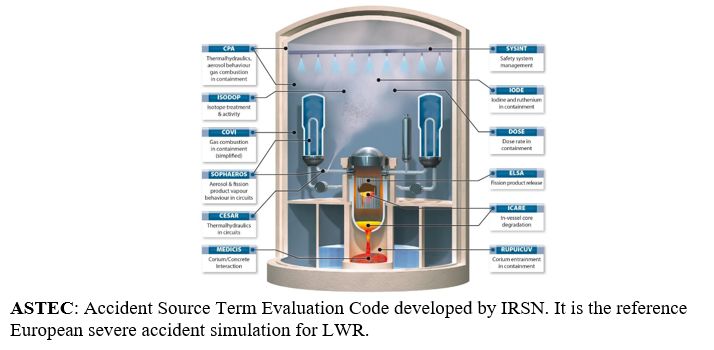
- ASTEC applications:
- Validation of the early-phase of PWR severe accident using the QUENCH-08 test data
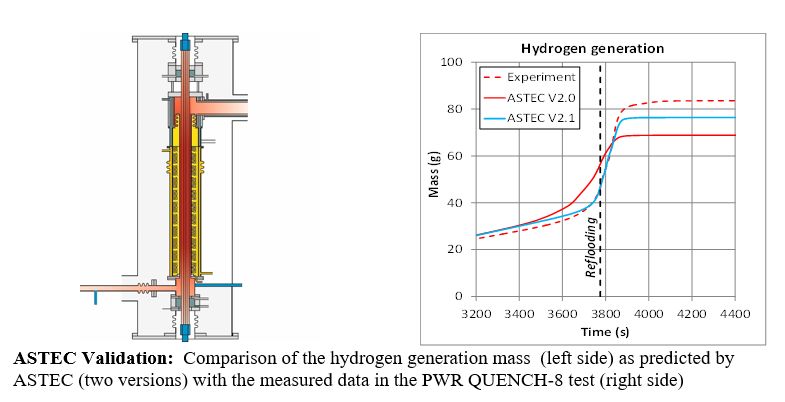
- ASTEC Simulation of a MBLOCA Severe Accident Sequence in a PWR:
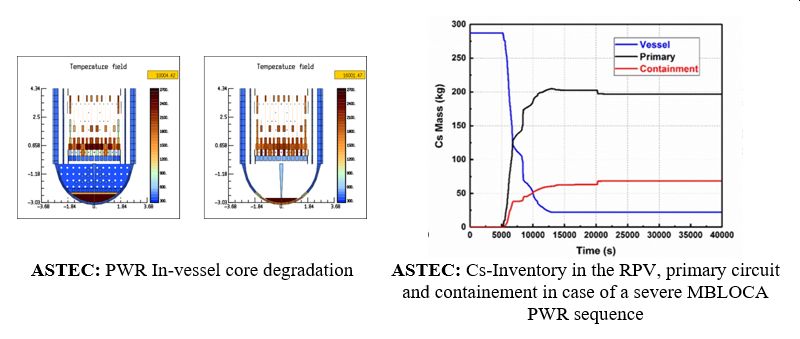
- The MELCOR: It is an integrated computer code for the analysis of the progression of severe accident sequences in Light Water Reactors. It is under development by the Sandia National Laboratory for the US NRC. (https://melcor.sandia.gov/about.html). KIT access to MELCOR is through the CSARP (Cooperative Severe Research Program) of the US NRC.
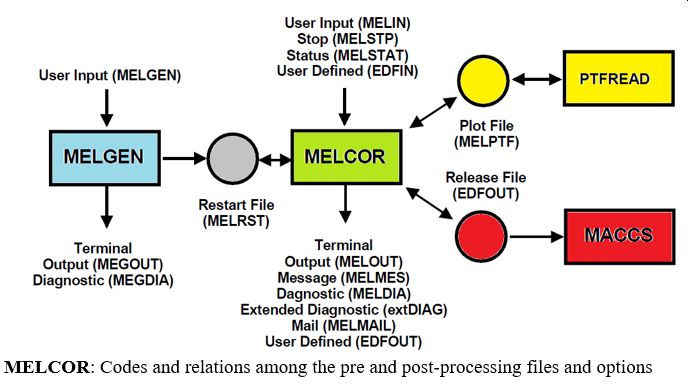
MELCOR Applications: Fukshima Unit 2 severe accident
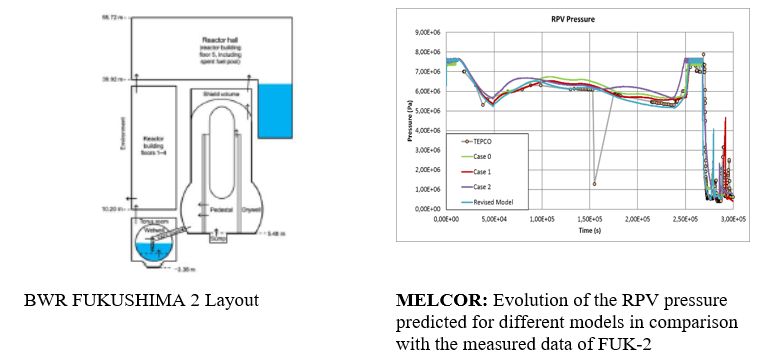
Validation of severe accident codes: The validation of integral codes is performed using experimental data focus in e.g. early (e.g. CORA, QUENCH, PHEBUS) and late in-vessel (e.g. LIVE, PHEBUS) phenomena, ex-vessel phenomena (e.g. MOCAK), containment phenomena or using the data from the few severe accidents e.g. TMI-2 or FUKUSIMA, which provide data for almost all phases of a severe accident.
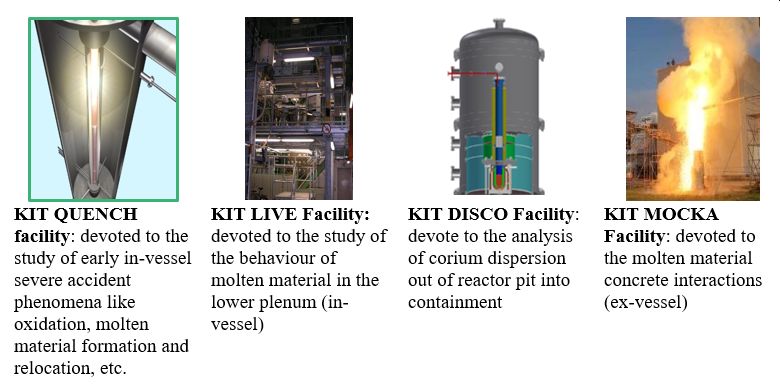
Papers
- Gabrielli, F., Sánchez-Espinoza, V.H., 2018. Uncertainty and Sensitivity Analysis by means of ASTEC/URANIE Platform of the QUENCH-08 Experiment, Proc. Of the 24th Int. QUENCH Workshop, November 13-15, 2018, Karlsruhe, Germany, DOI: 10.5445/IR/1000088229.
- Gabrielli, F., Sánchez-Espinoza, V.H., Stuckert, J., Gómez-García-Toraño, I., 2019. VALIDATION OF THE ASTEC INTEGRAL CODE USING THE QUENCH-06 AND QUENCH-08 EXPERIMENTS, Proc. of the 9TH European Review Meeting on Severe Accident Research (ERMSAR2019), Clarion Congress Hotel, Prague, Czech Republic, March 18-20, 2019.
- Mercan, A., Sánchez-Espinoza, V. H., Gabrielli, F., 2019. Validation of ASTEC2.1 using QUENCH-12 for VVER-reactors, Proc. Of the 9TH European Review Meeting on Severe Accident Research (ERMSAR2019), Clarion Congress Hotel, Prague, Czech Republic, March 18-20, 2019.
- Wang, S.; Muscher, H.; Sanchez-Espinoza, V.H, 2019. Pre-Test Analysis of QUENCH-20 BWR-Bundle with ASTEC, Proc. Of the 25 International QUENCH Workshop, Karlsruhe, Germany, October, 22-24.
- Onur Murat, O., Sánchez-Espinoza, V. H., Wang, S., Stuckert, J., 2020. Preliminary Validation of ASTEC V2.2b with the QUENCH-20 BWR Bundle Experiment, to be published on Nuclear Engineering and Design.
- Stakhanova, A., Gabrielli, F., Sánchez-Espinoza, V.H., Hoefer, A., Pauli, E., 2020 Uncertainty and sensitivity analysis of the QUENCH-08 experiment using the FSTC tool, Proc of the Best Estimate Plus Uncertainty International Conference (BEPU 2020), Giardini Naxos, Sicily, Italy, October 11-17, 2020.
- Ignacio Gómez-García-Toraño, Víctor-Hugo Sánchez-Espinoza, Robert Stieglitz, Cesar Queral; Analysis of primary bleed and feed strategies for selected SBLOCA sequences in a German Konvoi PWR using ASTEC V2.0. Annals of Nuclear Energy. Annals of Nuclear Energy Volume 110 (2017) 818-832. https://doi.org/10.1016/j.anucene.2017.08.003
- Ignacio Gómez García-Toraño, Víctor Sánchez Espinoza, Robert Stieglitz; Investigation of SAM measures during selected MBLOCA sequences along with Station Blackout in a generic Konvoi PWR using ASTECV2.0. Annals of Nuclear Energy, Volume 105, July 2017, Pages 226-239
- Rafael Bocanegra, Valentino Di Marcello, Victor H. Sánchez-Espinoza, Gonzalo Jiménez; Fukushima Unit 2 Accident Simulation with MELCOR 2.1. Journal of Nuclear Engineering and Radiation Science. doi:10.1115/1.4038062 History: Received September 26, 2016; Revised September 12, 2017
- Ignacio Gómez García-Toraño*, Víctor Sánchez Espinoza, Robert Stieglitz, Juri Stuckert, Laurent Laborde, Sebastian Belon; Validation of ASTECV2.1 based on the QUENCH-08 experiment. Nuclear Engineering and Design Volume 314, 1 April 2017, Pages 29-43. https://doi.org/10.1016/j.nucengdes.2016.12.039
- Valentino Di Marcello · Uwe Imke · Victor Sanchez; Validation and application of the system code ATHLET-CD for BWR severe accident analyses. Nuclear Engineering and Design 307 (2016), 284-298.
- Stakhanova, A., Gabrielli, F., Sanchez-Espinoza, V.H., Hoefer, A. and Pauli, E., 2023. “Application of the MOCABA algorithm and the FSTC tool for source term predictions during severe accident scenarios”. Annals of Nuclear Energy 184 p.109703.
- Stakhanova, A., Gabrielli, F., Sanchez-Espinoza, V.H., Hoefer, A. and Pauli, E., 2023. “Uncertainty and Sensitivity Analysis of the ASTEC Simulations Results of a MBLOCA Scenario in a Generic KONVOI Plant using the FSTC Tool”, submitted to Annals of Nuclear Energy (under review).
- Stakhanova, A., Gabrielli, F., Sanchez-Espinoza, V.H., Hoefer, A. and Pauli, E., 2022. “Uncertainty and sensitivity analysis of the QUENCH-08 experiment using the FSTC tool”. Annals of Nuclear Energy, 169, p.108968.
- Stakhanova A., Gabrielli F., Sanchez-Espinoza V.H., Pauli E., Hoefer A., 2022, "Uncertainty and Sensitivity Analysis of the ASTEC Simulations Results of a MBLOCA Scenario in a Generic KONVOI Plant using the FSTC Tool", Proc. of ERMSAR2022, 16-19 May 2022, Karlsruhe, Germany, DOI: 10.5445/IR/1000151444, https://publikationen.bibliothek.kit.edu/1000151444.
- Pauli E., Hoefer A., Gabrielli F., Stakhanova A., Sanchez-Espinoza V.H., 2022, "Predition of the Radiological Consequences of a Severe Accident Scenario in a Generic KONVOI Nuclear Reactor Plant", Proc. of ERMSAR2022, 16-19 May 2022, Karlsruhe, Germany, DOI: 10.5445/IR/1000151444, https://publikationen.bibliothek.kit.edu/1000151444.
- Gabrielli F., Stakhanova A., Sanchez-Espinoza V.H., Pauli E., Hoefer A., Feldmann H., 2022, "Impact of Realistic Fuel Inventories on the Radiological Consequences of a Severe Accident Scenario in a Generic KONVOI Plant by means of the ASTEC Code", Proc. of Kerntechnik, 21-22 Juni 2022, Leipzig, Germany
- Gabrielli F., Sánchez-Espinoza V.H., Stakhanova A., Hoefer A., Pauli E.M., 20121, "Source Term Evaluation Following MBLOCA and SBLOCA Scenarios in a Generic KONVOI-13000 NPP by Means of the ASTEC Code", EUROSAFE, 22-23 November 2021, Paris, France
- K. Mercan, F. Gabrielli and V. H. Sanchez-Espinoza, 2022, "Source Term Estimation and Dispersion Analysis of VVER-1000 Reactor in case of LBLOCA along with SBO”, Proc. of ERMSAR2022, 16-19 May 2022, Karlsruhe, Germany, DOI: 10.5445/IR/1000151444, https://publikationen.bibliothek.kit.edu/1000151444.
- K. Mercan, F. Gabrielli, V. H. Sanchez-Espinoza and W. Raskob, 2022, "Analysis of the consequences of a LBLOCA with SBO severe accident in a generic VVER-1000 by means of ASTEC and JRODOS codes," Nuclear Engineering and Design, vol. 400, p. 112078, 2022.
- K. Mercan, F. Gabrielli and V. H. Sanchez-Espinoza, 2022, "Validation of ASTEC2.1 using QUENCH-12 for VVER-Reactors," Nuclear Engineering and Design, vol. 395, no. 111840, ISSN 0029-5493, 2022.
- K. Mercan, F. Gabrielli and V. H. Sanchez-Espinoza, 2022, “Determination of the Radiological Consequences of a LBLOCA with SBO Severe Accident by means of the ASTEC and JRODOS codes at a generic Akkuyu VVER-1000 plant unit”, Proc. of the International Nuclear Sciences and Technologies Conference (INSTEC-2022), 19-22 October 2022, Kusadasi/Aydin
- Murat, O., Sanchez-Espinoza, V., Gabrielli, F., Stieglitz, R., and Queral, C., “Analysis of the Short Term-Station Blackout Accident at the Peach Bottom Unit-2 Reactor with ASTEC Including the Estimation of the Radiological Impact with JRODOS”, Submitted to Nuclear Engineering and Design (under review) - SSRN: https://ssrn.com/abstract=4305365
- Gabrielli, F., Sanchez Espinoza, V.H., Murat, O., Mercan, A.K., Tromm, W., 2021, “Employment of the ASTEC Code in the Severe Accidents Research Activities at KIT”, 30th International Conference Nuclear Energy for New Europe, September 6-9, 2021.
- Murat, O., Sanchez-Espinoza, V., Wang, S., and Stuckert, J., 2020, “Preliminary validation of ASTEC V2.2.b with the QUENCH-20 BWR bundle experiment”, Nuclear Engineering and Design, Vol. 370, No. 15, 2020. DOI: 10.1016/j.nucengdes.2020.110931
- O. Murat, 2022, “Peach Bottom Unit-2 ASTEC V2.2.0.1 Model and Stationary Results”, Proc. of ERMSAR2022, 16-19 May 2022, Karlsruhe, Germany, DOI: 10.5445/IR/1000151444, https://publikationen.bibliothek.kit.edu/1000151444.
- O. Murat, V.H. Sanchez-Espinoza, R. Stieglitz, “Analysis of QUENCH-20 Test with ASTEC V2.2.b”, 26th International QUENCH Workshop, 6-9 December 2021, DOI: 10.5445/IR/1000141824, https://publikationen.bibliothek.kit.edu/1000141824.
